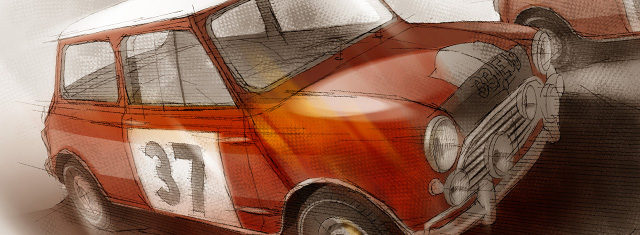 |
|
|
Název rubriky |
fin | Mini Cooper |
| Název článku | 3x Monte Carlo |
| Autor článku | Pavel Hrubý |
| architekt | designér | |
| Místo původu | Spojené království Velké Británie a Severního Irska |
| Výrobce | British Motor Corporation (BMC) |
| Konstruktér |
Alexander Issigonis | John Newton Cooper |
| Chronologie | 1959 zahájení produkce modelu Mini |
| 1961 zahájení produkce modelu Mini Cooper | |
| 1963 zahájení produkce modelu Mini Cooper S | |
| 1964, 65, 67 vítěz Rally Monte Carlo | |
| Name of the rubric |
fin | Mini Cooper |
| Article title | 3x Monte Carlo |
|
Autor of the article |
Pavel Hrubý |
|
|
architect | designer |
|
|
|
|
Place of origin |
Great Britain and North Ireland |
|
Producer |
British Motor Corporation (BMC) |
|
Constructor |
Alexander Issigonis | John Newton Cooper |
|
Chronology |
1959 production start of the Mini model |
|
|
1961 production start of the Mini Cooper model |
|
|
1963 production start of the Mini Cooper S model |
|
|
1964, 65, 67 winner of the Rally Monte Carlo |
|
|
|
|
|
|
|
Konstruktér, designér a automobilová závodní legenda John Cooper odvedl skutečně brilantní práci. Díky svým bohatým zkušenostem dopomohl přetvořit sériové Mini v dospělý závodní speciál.
V důsledku suezské krize a obavy z nedostatku pohonných hmot se v Evropě koncem 50. let 20. století zvýšila poptávka po malém městském automobilu. V tomto ohledu koncern British Motor Corporation nezaváhal a svěřil návrh čtyřmístného vozu konstruktéru Alexandru Issigonisovi. Ten přišel s tehdy netradiční koncepcí přední poháněné nápravy a vpředu příčně uloženého motoru. Vytěžil tak maximální vnitřní prostor z minimálních vnějších rozměrů karoserie. Sériový model byl od roku 1959 dodáván pod značkami Austin a Morris. Za 41 let produkce původní generace ho bylo vyrobeno na 5,5 milionů kusů.
Netrvalo dlouho a koncern podpořil myšlenku postavit toto originální vozítko i na start soutěžních tratí. Závodní speciál Mini byl označen přízviskem Cooper po svém tvůrci a o dva roky později vznikl ještě výkonnější Mini Cooper S. Od standardního provedení se lišil upraveným podvozkem, kotoučovými brzdami na předních kolech a řadovým přeplňovaným čtyřválcem o objemu až 1 275 cm3. Pro splnění podmínek homologace se tato verze, v „civilnějším“, dokonce 56kilowatovém provedení, dostala na běžný trh, a to hned v počtu několika desítek tisíc exemplářů.
K jeho největším úspěchům bezesporu patří vítězství v jedné z nejstarších automobilových soutěží Rally Monte Carlo v letech 1964 a 1965. V roce 1966 zde byly hned tři posádky Mini z prvních pozic za sporných okolností diskvalifikovány, ale už následující rok Mini opět zvítězilo.
Developing engineer, designer and car racing legend, John Cooper, did a brilliant piece of work. Thanks to rich experience he helped to recreate the serial Mini into a mature racing special.
As a result of the Suez Crisis and fears of fuel shortage in Europe in the late 50s of the 20th century, there was a higher demand for a small urban car. In this regard, British Motor Corporation didn’t hesitate and gave the design of a four-door car to developer Alexander Issigonis. He then came up with an untraditional concept of a front driven axle and a transversely mounted front engine. He gained maximum interior space from minimal exterior body dimensions. The serial model was sold from 1959 under brands Austin and Morris. During the 41 years of production, the original generation was produced at 5.5 million pieces.
Before long, the concern supported the idea of putting this original vehicle onto the starting line of completion tracks. The racing Mini special was nicknamed Cooper after its creator and two years later came the even more powerful Mini Cooper S. It differed from the standard version with a modified chassis, disk brakes on the front wheels and an in-line turbocharged four-cylinder with a volume of 1275 cm3. Due to complying with homologation this version, in a more ‘civil’ 56-kW version, got onto the common market and that in the tens of thousands of specimens.
Among its biggest success is undoubtedly the victory in one of the oldest car races, the Rally Monte Carlo during years 1964 and 1965. In 1966, three Mini teams were disqualified from leading positions under questionable circumstances, but the following year Mini once again took the win. |
|
| fotogalerie | photogallery | ||||||||
 |
 |
 |
||||||
| zpět na publikované články | back to the published articles | ||||||||